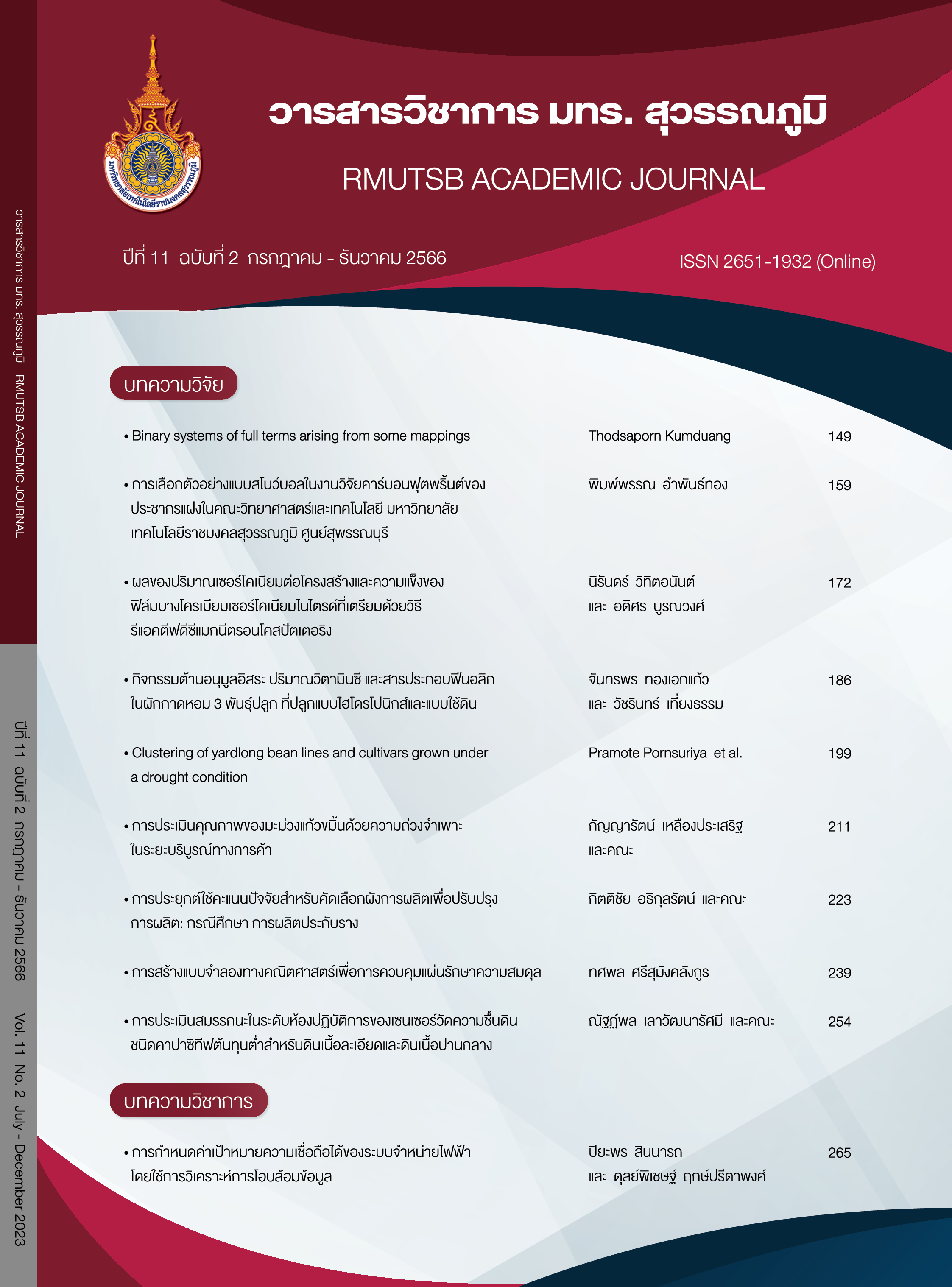Quality evaluation of Kaew Kamin mango with specific gravity at commercial maturity stage
Main Article Content
Abstract
Kaew Kamin mango is one of the economic important crops of Sa Kaeo province. Generally, Kaew Kamin mango is consumed in the unripe stage with crunchy texture, slightly sour and sweet taste. The best quality of mango depends on suitable harvesting stage (maturity), however most farmers classify the maturity stages by visual assessment which lack of accuracy. Therefore, this research aimed to study in relationship between specific gravity (SG) and physicochemical and physiology properties of the mango quality at commercial maturity stage. Unripe mangoes at commercial maturity stage were cleaned and divided into two groups: floating in water (T1) and sinking in water with floating in 2% sodium chloride (NaCl) solution (T2). The physical, chemical and physiological properties for each mango group were investigated. It was found that fresh weight, total soluble solids content (TSS), titratable acidity content (TA) and moisture content of mangoes varied significantly (p<0.05) with both floating and sinking in water. T2 group was showed the good properties for unripe mangoes, considering as mature. The peel was light green color with L*, a*, b*, C* and H° values of 60.80, -10.06, 36.79, 40.63 and 105.57, respectively. The pulp of mango was orange-yellow color with L*, a*, b*, C* and H° values of 75.30, 3.54, 42.48, 41.97 and 85.94, respectively. Its pulp had high starch concentration and TSS (9.24 °brix). TA and moisture content of T2 group were low values at 3.75% and 85.13%, respectively, which were significantly different compared to T1 group. In conclusion, SG method can be used to separate the Kaew Kamin mangoes quality at commercial maturity stage.
Article Details

This work is licensed under a Creative Commons Attribution-NonCommercial-NoDerivatives 4.0 International License.
Published manuscript are the rights of their original owners and RMUTSB Academic Journal. The manuscript content belongs to the authors' idea, it is not the opinion of the journal's committee and not the responsibility of Rajamangala University of Technology Suvarnabhumi
References
Abu, M., Olympio, N. S., & Darko, J. O. (2020). Appropriate harvest maturity for mango (Mangifera indica L.) fruit using age control and fruit growth and development attributes. Horticulture International Journal, 4(5), 213-219.
Abu, M., Olympio, N. S., & Darko, J. O. (2021). Determination of harvest maturity for mango (Mangifera indica L.) fruit by non-destructive criteria. Agricultural Sciences, 12, 1103-1118.
AOAC. (2000). Official methods of analysis (17th ed.). Arlington, VA: Association of Official Analytical Chemist.
Bang Khae Girl 22. (2022). Kaew Kamin mango new economic crops of Sa Kaeo. Retrieved 1 March 2023, from https://www.technologychaoban.com/agricultural-technology/article_55332 (in Thai)
Dadzie, B. K., & Orchard, J. E. (1997). Routine post-harvest screening of banana/plantain hybrids: criteria and methods. Rome: International Plant Genetic Resources Institute.
Delwiche, M. J., Arevalo, H., & Mehischau, J. (1996). Second generation impact force response fruit firmness sorter. Transactions of the ASAE, 39(3), 1025-1033.
Hong, J. H., & Gross, K. C. (1998). Surface sterilization of whole tomato fruit with sodium hypochlorite influences subsequent postharvest behavior of fresh-cut slices. Postharvest Biology and Technology, 13, 51-58.
Ittafaqul Azad, M., Golum Mortuza, M., Al-Amin, M., Naher, M. N. A., & Khorshed Alam, S. M. (2009). Qualitative analysis of mango (Mangifera indica L.) fruits at different maturity stages. The Agriculturists, 7(1&2), 1-5.
Jarimopas, B., & Kitthawee, U. (2007). Firmness properties of mangoes. International Journal of Food Properties, 10, 899-909.
Ketsa, S., Rattanamalee, S., & Bahprasert, C. (1991). Growth, development, biochemical changes and harvesting index of mango (Mangifera indica L.) cv. Tongdum. Kasetsart Journal: Natural Science, 25(4), 391-399. (in Thai)
Punfujinda, C., Chumkaew, K., Gaveevangso, A., Atthatham, A., & Suttapong, S. (2019). Effects of ground dried basil leaves on chemical composition and sensory acceptance of bread. RMUTSB Academic Journal, 7(2), 192-204. (in Thai)
Siripattanakul, W., Tuntratian, S., & Charittsean, T. (2002). Maturity and aging condition of mango variety Sam-pee for mango juice production. Proceeding of the 40th Kasetsart University Annual Conference: Plants, Agricultural Extension and Communication, Ago-Industry (pp. 413-420). Bangkok: Kasetsart University. (in Thai)
Singh, B., Singh, H., Chakraborty, I., Panja, P., & Hynniewta, L. (2014). Physicochemical properties of three commercial varieties of mango (Mangifera indica L.) in West Bengal. National Seminar on Integrated Approaches in Horticulture for Sustainable Development. Visva-Bharati, Sriniketan, West Bengal: Palli Siksha Bhavana (Institute of Agriculture).
Sombatpraiwan, S., Tipyavimol, T., & Treeamnuk, K. (2012). Postharvest changes in quality characteristics of Nam Dokmai mango. Proceeding of the 13rd the Thai Society of Agricultural Engineering (pp. 518-525). Chiangmai: The Thai Society of Engineering. (in Thai)
Techno Kaset. (2021). Investigate the path of fruits that make money, Kaew Kamin, cross the border to seize Thailand. Retrieved 1 March 2023, from https://www.technologychaoban.com/agricultural-technology/article_180119 (in Thai)
Tridjaja, N. O., & Mahendra, M. S. (2000). Maturity indices and harvesting practice of “Arumanis” mango related to the target market. Journal of Agricultural Technology, 1(3), 17-22.
USDA. (2017). Equipment catalog for fresh and processed products inspections. Washington, D.C.: Equipment & Forms Depot USDA.


